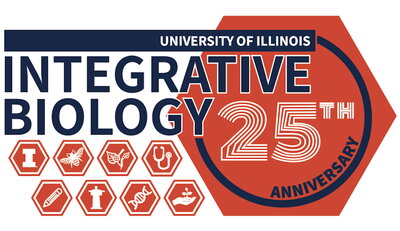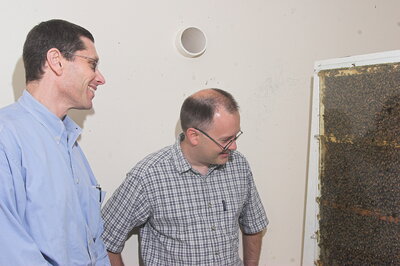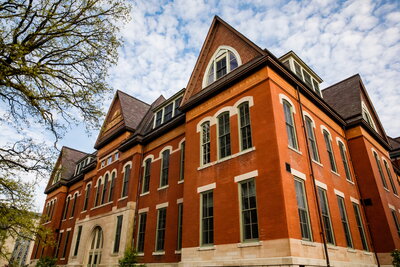
As SIB marks its 25th anniversary, the occasion offers an opportunity to reflect on how far the School has come and how much SIB has shaped biology education and research at Illinois. SIB was formally recognized by the university on July 1, 2000, after emerging from a pivotal reorganization of the School of Life Sciences. While other units pursued molecular specializations, SIB was formed around a unifying principle: that understanding life requires an integrative approach across all levels—from genes to organisms to entire ecosystems.
From the beginning, SIB stood out not only for its scientific vision, but for its structure. The school brought together the departments of Entomology, Evolution, Ecology, and Behavior (EEB), and Plant Biology, in a shared commitment to interdisciplinary collaboration. Under the direction of founding director Fred Delcomyn, SIB focused on creating a culture of cohesion, where space and resources were managed collectively, and faculty worked across traditional boundaries. That groundwork enabled the school to grow, attract top talent, and adapt to new challenges over the years.

Since then, SIB has been marked by defining milestones. Within four years of the separation, the school incorporated its Merit Program which consists of using a highly trained facilitator-instructor to stimulate student-student interactions. In 2006, the launch of the Integrative Biology Honors program gave high-achieving undergraduates a new pathway for advanced study and research. That same year, Professor Gene Robinson opened the Bee Research Facility, laying the foundation for groundbreaking work in behavior and genomics. A year later, Delcomyn concluded his tenure as director, handing leadership to Evan DeLucia, whose time at the helm coincided with a dynamic period for both infrastructure and academics. The opening of the Carl R. Woese Institute for Genomic Biology, as well as the formation of the graduate Program in Ecology, Evolution, and Conservation Biology (PEEC), marked this moment as one of expansion and redefinition.
By the 2011–2012 academic year, the school’s undergraduate population doubled. Alongside that growth came a shift in how courses were taught. Traditional lecture formats gave way to active learning models, making classes more engaging and participatory. Faculty would attend workshops that were held to introduce active learning methods, with one Saturday workshop devoted strictly to promote the idea. That same year saw the launch of the Professional Science Master’s in Plant Biology degree, which combined scientific training with business and communication skills, addressing new demands in the job market.
A major turning point arrived between the academic years of 2013 to 2015, when DeLucia stepped down and Carla Cáceres became the school’s third and current director. During those years, SIB saw the largest hiring of current faculty, with Julian Catchen, Jessica Conroy, Alexandra Harmon-Treatt, Amy Marshall-Colon, James O’Dwyer and Wendy Yang all joining the SIB community. These hires brought fresh energy, expertise, and new areas of research to the school. The momentum continued the following year with the launch of several undergraduate awards, generously funded by alumni and friends of the school. These included the Bob and Tammy Camp Family Award, the Alice Hayes Award, the Allan Malmed Award, and the Spyros Kavouras Award, established by alumnus Jerry Kavouras in memory of his father.

In 2017–2018, SIB transitioned into the beautifully renovated Natural History Building, an iconic space that now serves as home base for students in the IB curriculum as well as the SIB Academic Support Team. That year also marked Stephen Downie’s appointment as Associate Director for Academic Affairs and the launch of the Alumni Mentor Program, thanks to the leadership of Christina Swanson. Continuing to build community among alumni and current students, the SIB Alumni Award program debuted in 2018–2019, recognizing outstanding contributions from graduates in a wide range of fields.
The school’s curricular offerings also evolved. In 2019–2020, EEB officially took its current name, which more accurately reflects its scope. The following year, like many institutions around the world, SIB adapted swiftly to the challenges of the COVID-19 pandemic, transitioning to virtual and hybrid learning with resilience and creativity. These flexible teaching strategies remained in use through the 2022–2023 academic year.
Most recently, the 2022-2023 academic year also saw the installation of a striking woolly mammoth sculpture near the Natural History Building, which is emblematic of SIB’s enduring connection to Earth’s deep past and ongoing commitment to understanding life in all its forms.
As SIB celebrates this milestone, it stands not just as a school, but as a community of scientists, educators, and students who have built something lasting together. The journey from a fledgling school to a vibrant community of innovative biologists is a tribute to their dedication. And with a strong foundation, a collaborative spirit, and a future-focused mission, the next 25 years of Integrative Biology at Illinois promise to be just as impactful as the first.